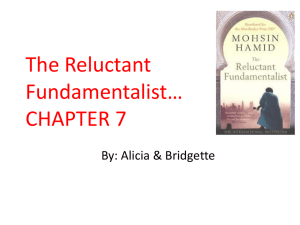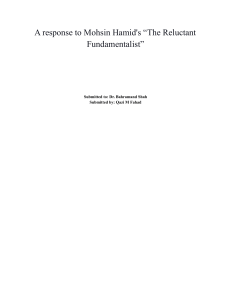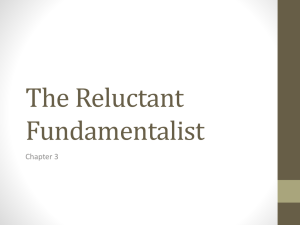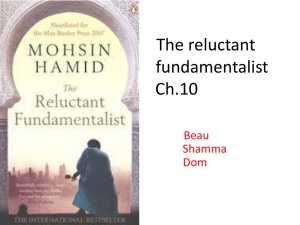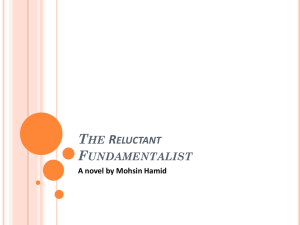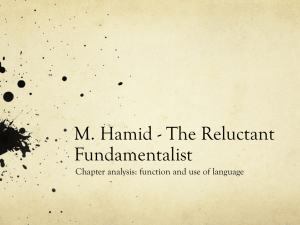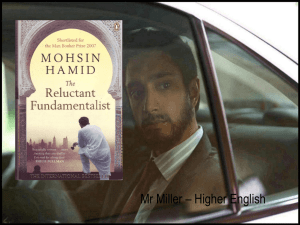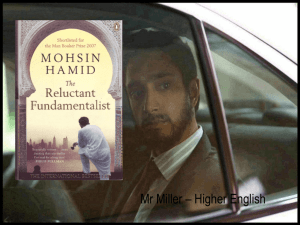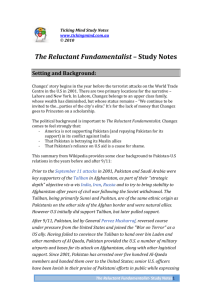The Reluctant Fundamentalist: Character Analysis
advertisement
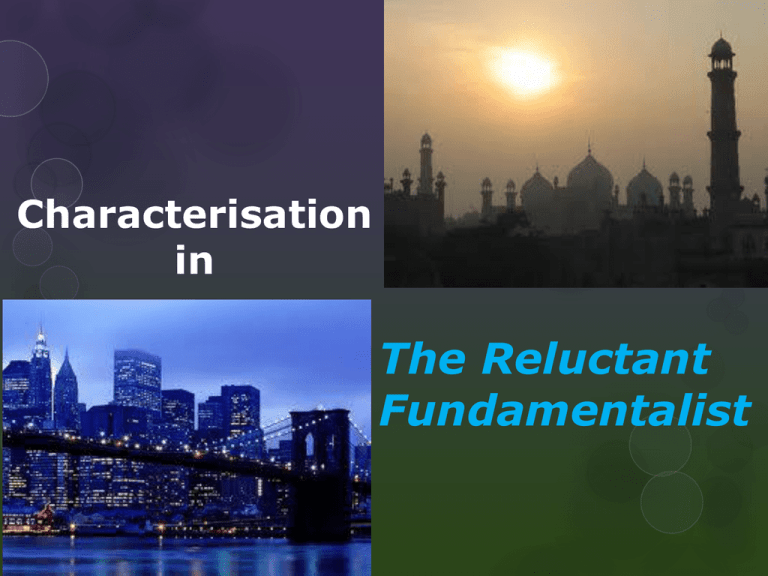
Characterisation in The Reluctant Fundamentalist Characters Overall, the characters in The Reluctant Fundamentalist are simultaneously human and symbolic. In other words, Hamid fashions them human identities through character development, but he also uses them as symbols to illustrate the novel’s larger motifs and themes. Because the characters are human, they are not plain and uncomplicated symbols such as the characters in an allegory. Rather, as humans, they occasionally do and say things that contradict their symbolic meanings. By using character development and symbolism simultaneously, Hamid creates a complex and multilayered tale. The Reluctant Fundamentalist’s multifaceted nature makes the story rich but also ambiguous: the questions that Hamid raises often lack definitive answers. Changez Narrator and protagonist Pakistani from Lahore Mid twenties Graduates from Princeton Little money – financial aid – 3 jobs Polite and formal – different – raised in upper class society His polite manner helps him at Underwood Samson Jim takes a special interest – similar backgrounds Falls in love with Erica he meets in Greece After 9/11 realise can’t keep Erica or his job – opposes ”maximum efficiency” Returns to Lahore, becomes uni lecturer, makes statements labelled ”anti-American”, popular with students The American Never named – what does this do? His nationality is easily guessed Tall, barrel chested, looks like “ a seasoned army officer” Fancy cell phone – contacted on the hour and always texts back Bulge in jacket Sits with back to wall Knows Manhattan well and has travelled to the East Uncomfortable with Changez’s reaction to 9/11 Begins to question if C is telling the truth Glances over shoulder as walking down Mall Road. Wonders if they are being followed Reaches for something metallic in his pocket Erica Wealthy, athletic Manhattan socialite Detached, sinking into depression Inspired to write by grief Her love for Chris prevents her from becoming truly intimate with Changez Eventually committed to a mental health clinic by the Hudson River Clothes are found neatly folded by river Symbolic of America – C’s relationship: C is at odds with her just as he is at odds with America Jim C’s boss at Underwood Samson Middle aged Princeton alumnus Poor background Look of seasoned army officer Takes special interest in C When C visits Jim’s apartment, he sees nude males among his artworks Senior valuer – sees thru people easily Finds it easy to evaluate without becoming emotionally involved – a true valuer (blind to human cost) Remains supportive of C, even tho’ he has to fire him Wainwright Colleague and friend at US Father from Barbados Ranked second to C Light-hearted and social Likes to quote movie lines first person to dance at Jim’s party in the Hamptons Doesn’t lose trust of C after 9/11 Tries to help C Juan Bautista Runs music business in Valparaiso that US is valuing Resembles C’s grandfather Thick glasses, cane, walks slowly Juan-Bautista tells C about the janissaries and suggests C is like them Directs C to Pablo Neruda’s house – encouraging him to become a revolutionary, a change of heart follows for C as he vows to become an ex-janissary and see America thru clear eyes John and Baptist - like him to C – cleanses C of his conflict and helps him find a new way to live his life Minor Characters of Note – read at home The waiter The waiter is a large and imposing man. He continually approaches the table to wait on the American. At the novel’s end, he is walking on the road behind them. The American seems to distrust the waiter. Chris Chris is a character that never actually appears in the story, although he plays a significant role. He was Erica’s first and only love, an artist “with long skinny fingers” (28). Chris was like Erica’s brother until they became romantically involved in high school; she calls him her “home.” Chris, or the idea or memory of him, consumes Erica’s thoughts and eventually devours her when she (presumably) commits suicide. Sherman Sherman is a vice president at Underwood Samson who gives the trainees their orientation on their first day of work. Therefore, Sherman is Hamid’s mouthpiece for stating the ethos of Underwood Samson— and, symbolically, America. He is also the person who initiates Changez and the other new hires into using their expense accounts. He takes them out for a bottle of champagne and, before leaving, tells them to drink to their hearts’ content. The Filipino driver The Filipino driver glares at Changez when they are both stopped at an intersection in Manila. Although we do not know why he stares Changez down, his gesture makes Changez aware of his inner conflict regarding what it means to work in corporate America. The cashier The cashier works at the Pak-Punjab Deli in New York City. He gives Changez a free breakfast on his first day of work. That night, Changez tries to pay him with his American Express corporate charge card. The nurse The nurse is a friendly woman who works at the clinic where Erica is sent. She is Erica’s go-between both times Changez visits. On the second visit, the nurse tells Changez about Erica’s disappearance and shows him the place where her clothes were found. The nurse, like the wall on the island of Rhodes, represents the emotional and moral barrier that separates Erica and Changez. The man in the parking lot The man in the parking lot accosts Changez and speaks to him in nonsense syllables meant to sound like Arabic. He creates Changez’s first direct and personal experience of prejudice in the post-9/11 climate. Chuck and Mike Chuck is Changez’s college soccer buddy who invites him to Greece. Mike is Chuck’s friend and a rival for Erica’s affections. Both Chuck and Mike are wealthy Princetonians, members of the Ivy dining club. Chuck and Mike are important because they are generic characters; they represent a certain class of people and their individual identities are unimportant. In this case, they represent the type of spoiled, impolite young American that annoys Changez. Hamid underscores Chuck and Mike’s similarity by making their names similar. As Changez remarks, they are “monosyllabically monickered” (18). Incidentally, the common thread of monosyllabic names extends to a major character: Jim. Jim is not a generic character; Hamid gives us a clear sense of what makes him unique, and he is not from the same background as Chuck and Mike. However, Jim’s position in corporate America connects him to Chuck and Mike; he may be a compassionate person, but he is also a typical American in his quest for profitability at any cost. Erica’s Parents Erica’s parents are wealthy, educated, and elite Manhattanites. When Changez comes to their penthouse apartment for dinner, Erica’s father unwittingly offends him with his brief, cold summation of Pakistan’s political state. Changez has more interactions with Erica’s mother, because she—like the nurse—is a go-between in Changez’s relationship with Erica. When Changez visits her after Erica’s disappearance, she gives him Erica’s manuscript. Changez’s Family Changez family once belonged to Lahore’s wealthy elite class. They are still elite, but their economic situation has been deteriorating for several generations. According to Changez, his relatives are addicted to nostalgia because the reality of their financial decline is too painful to bear. Their resulting debts, arguments, and emotional problems wreak havoc on the whole family. When the conflict between India and Pakistan begins, some of Changez’s relatives begin making emergency preparations. After his visit to see his parents, Changez feels guilty that he is leaving the country instead of fighting for it. Conclusion In this section, we learned that: Overall, Hamid treats characters both as individuals and as symbols. He uses character development simultaneously with symbolism. The novel’s main characters are Changez, the American, Erica, Jim, Wainwright, and Juan-Bautista. The American’s ambiguity, including his namelessness, makes it easy for the reader to put himself in the American’s position. Chuck, Mike, and Jim all have monosyllabic names that connect them to the idea of a generic, spoiled and impolite American. Moving on… Now that you have learnt about the characters and how Hamid developed them, turn to the Running Sheet DLA, and begin your work on this assignment. Think carefully about the characters and how they have been crafted as you respond to the scenes on the running sheet list.
